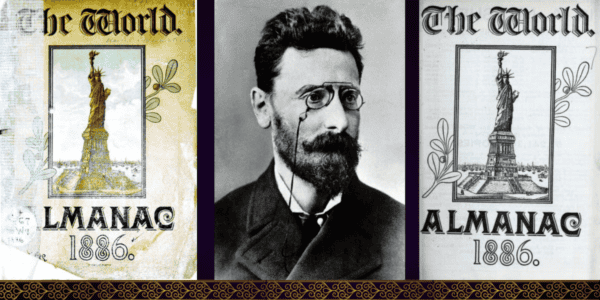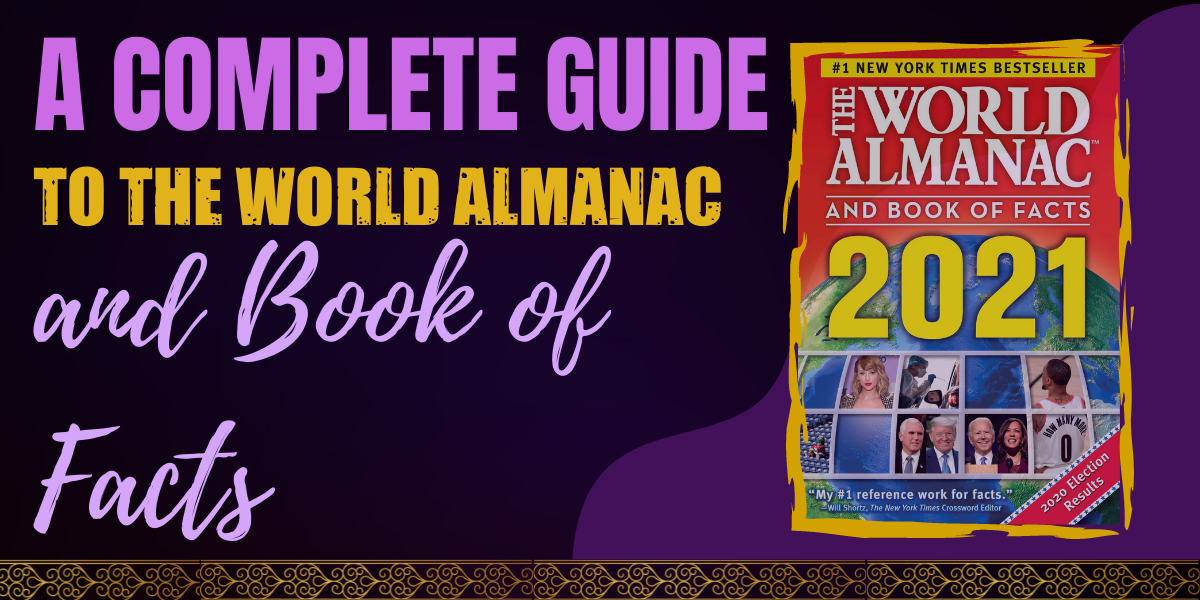For more than 150 years, The World Almanac and Book of Facts have provided an annual round-up of the most important global and political events, scientific discoveries, and sporting feats of the previous year.
And, since it was first published way back in 1875, it’s also become America’s all-time best-selling reference book. This compendium of information has sold more than 83 million copies so far. It is used by schools, libraries, homes, and businesses around the country and further afield.
It’s the oldest and most respected educational resource in the US, and it’s still as popular as ever today. The 2021 edition didn’t disappoint. With the 2022 edition being published, any day now, trivia fans are excitedly awaiting this year’s offering up and down the country.
Each edition is packed with fascinating information around the world, separated into sections such as “Surprising Facts,” “Americans by the Numbers,” “Number Ones,” “Milestone Birthdays,” “Offbeat News,” “Notable Quotes,” and “Historical Anniversaries,” just to name a few.
But how did the World Almanac and Book of Facts become the trusted resource it is today? Let’s take a look at some of its long, rich history and find out…
The History of The World Almanac and Book of Facts
The First Edition
The World Almanac and Book of Facts were initially known as simply The World Almanac. It took its name from the original publishers, the New York World newspaper, nicknamed ‘The World’.
The very first edition contained 120 pages of the most crucial information of the time, along with 12 pages of advertising. It was published in 1868, just three years after President Abraham Lincoln was assassinated at the end of the American Civil War. This was a time when there were still only 38 states in the union, and the average American worker made just 17 cents per hour.
A large section of this first edition was dedicated to the Reconstruction Acts of post-Civil War America and the progress made so far. Other stories, such as the impeachment of then-president Andrew Johnson, the great New York Winter Garden Theatre fire, and an eyebrow-raising feature entitled ”Indians troublesome, and 8,000 US troops ordered to the Plains” also made the cut that year.
Celebrating Lady Liberty

Despite a few years of moderate success, the publication was suspended in 1876. This compendium of universal knowledge almost didn’t survive.
But thankfully, just shy of a decade later, in 1886, it was revived by the new owner of The World newspaper, Joseph Pulitzer. Pulitzer was determined to make his publication one of the most respected and influential newspapers in the nation. He believed that reinstating The World Almanac would help him do just that.
That first rebooted edition in 1886 depicted the Statue of Liberty on its front cover. But for Joseph Pultizer, this wasn’t just a display of patriotism or national pride. Instead, it was a celebration of his own role in the statue’s construction.
The previous year, the American Committee for the Statue of Liberty ran out of funds before the structure could be completed. So Pulizar himself helped to fund the remainder of the project, using his newspaper to help him. He even published a piece in The World, urging the public to support his noble mission.
“We must raise the money!” he wrote. “The World is the people’s paper, and now it appeals to the people to come forward and raise the money. The $250,000 that the making of the Statue cost was paid in by the masses of the French people- by the working men, the tradesmen, the shop girls, the artisans- by all, irrespective of class or condition. Let us respond in like manner. Let us not wait for the millionaires to give us this money. It is not a gift from the millionaires of France to the millionaires of America, but a gift of the whole people of France to the whole people of America.”
Thanks to his efforts, he managed to raise over $100,000, an incredible sum at the time, in less than six months, which ensured that Lady Liberty would indeed stand proud for centuries to come.
And so, the 1886 edition of The World Almanac features the Statue of Liberty standing proudly over the New York Harbour. Later commemorative versions of this landmark edition also featured the statue standing between two globes, one depicting the Americas, and the other, Europe, to symbolise the friendship and cooperation between the people of France and the United States.
But despite Pulitzer’s accomplishment and the ever-growing success of his newspaper, he was reportedly unhappy with that first revived edition of The World Almanac. “That it has not received the measure of my concept is perhaps because I had not time enough at my disposal to do all I had planned,” he wrote.
Still, it’s clear that his work has made a lasting impact on history, and since he brought The World Almanac back to life, it’s been published every year since.
An Annual Compendium of Universal Knowledge
In the forty years that followed, The New York World Building, also known as the Pulitzer Building, was a prominent feature on The World Almanac’s cover, paying homage to its journalistic roots.
It grew from strength to strength. Less than a decade after Pulitzer revived the almanac, it had over half a million dedicated subscribers, and that number was growing quickly.
To celebrate the publication’s success and raise its profile, in 1894, it took on a new title; The World Almanac and Encyclopedia. This was the name it kept until almost thirty years later when a third and final rebrand saw it become The World Almanac and Book of Facts, the name it still bears today.
Documenting the 20th Century

By the time the 20th edition was published back in 1906, The World Almanac was considered to be a beacon of knowledge for the new world. To celebrate this milestone anniversary, the New York Times ran a special feature, declaring “the almanac has made for itself a secure position, second only to the forty-year-old Whitaker’s Almanac of London, with which alone it can be compared.”
For the decades that followed, it documented the monumental global changes of the 20th Century, never missing a year.
And while, in those early days, The World Almanac was limited to US soil, during the Second World War, its reach went global.
Between 1944 and 1946, the US government ordered an additional 150,000 copies into print to be distributed to US troops stationed worldwide. This not only kept American soldiers connected and informed, but it also exposed the almanac to foreign allied troops, putting it on the international stage.
By the mid-1980s, The World Almanac and Book of Facts had become such a popular resource for families, educational facilities, research librarians, businesses and entrepreneurs, that it was crowned the number one bestselling book in the New York Times Advice, How-to, and Miscellaneous category. It sold a whopping 1,760,000 copies that year, adding to its grand total today of over 83 million.
During that time, the almanac had only a small yet dedicated ten-member team who worked around the clock throughout the year to ensure the annual publication was of the highest possible quality.
And in these pre-internet days, this was no easy feat. Each and every fact from the previous year would need to be checked, corrected, or updated, and brand new information from around the world had to be gathered, verified and summarised in a way that was accessible to their vast readership.
And although this is a book about facts, The World Almanac has also had to rely on a certain degree of guesswork over the years too. That’s because each edition is published before the title year has begun, usually in the fall. This is a huge challenge for the team’s researchers, especially during election years and times of significant ongoing global events.
But while there have been various corrections and retractions over the years, collectors place a particularly high value on older, original editions with the errors still intact.
An Enduring Reputation
Despite the occasional human error and misplaced predictions, The World Almanac and Book of Facts entered the 21st Century with its reputation stronger than ever. And even today, it’s still considered one of the most trusted and respected compendiums of information in the world.
The 2021 edition, overseen by senior editor Sarah Janssen, was a New York Times Bestseller. Unsurprisingly, this particular edition had a lot to talk about. There’s an entire section dedicated to the 2020 Coronavirus pandemic that shook the world, as well as a feature on the rollercoaster US presidential elections, with an in-depth analysis of the election process and comprehensive voting results from every state.
And since sports fans worldwide missed out on the 2020 summer Olympics, this special edition of the almanac also includes a look back at history’s most memorable Summer Olympic moments of all time.
The 2022 edition is about to hit the shelves any day now, just in time for Christmas. Teasers from the publishers tell us there will be an updated, in-depth analysis of the ongoing Coronavirus Pandemic, as well as the Top 10 news stories that have grabbed the world’s attention during 2021.
There will also be the usual round-up of the year in sports and sections dedicated to the world in photographs, the most bizarre news stories from around the globe, the legacy of Donald Trump’s presidency, plus newly released data from the 2020 census.
Fun Facts About The World Almanac and Book of Facts
- In 2018, The World Almanac and Book of Facts celebrated its 150-year anniversary.
- The 1985 video game ‘Where in the World is Carmen Sandiego?’ offered customers a free copy of the almanac with every game purchased.
- President Calvin Coolidge’s father referenced The World Almanac during the swearing-in speech of his son’s inauguration.
- The almanac was also a favorite information resource of President John F. Kennedy and President Bill Clinton.
- In 1995, The World Almanac released its first spin-off edition for kids.
- The Alamac has featured heavily in Hollywood movies over the years. It’s referenced by Bette Davis in All About Eve, Audrey Hepburn in Love in the Afternoon, Fred MacMurray in Double Indemnity, and Rosie Perez in White Men Can’t Jump.
The book is also used as evidence in a trial to determine whether Santa Claus is real in the classic movie Miracle on 34th Street. Will Smith used it to check what time the sun would set in the post-apocalyptic movie; I Am Legend.
Conclusion
With a legacy spanning over 150 years, The World Almanac and Book of Facts is one of the most enduring reference books of all time. And although we rely on the internet for much of our knowledge these days, this bestselling annual book is as popular with readers as ever.
It’s the perfect gift for fans of trivia and a great collector’s item that lets you own your own fascinating record of global history spanning three centuries. If you love learning new things, and you can’t wait for the next installment of the World Almanac and Book of Facts, then check out my recent post about the best nonfiction books of the 21st Century. You can also boost your brainpower with my guide to the top 11 books that will make you smarter.



